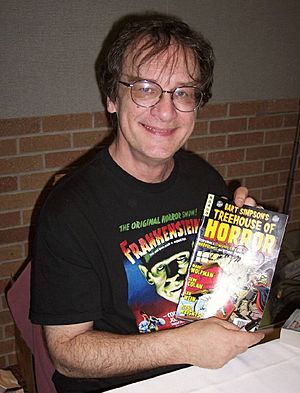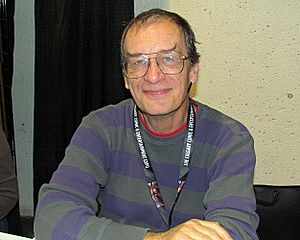Bernie Wrightson facts for kids
Quick facts for kids Bernie Wrightson |
|
|---|---|

Wrightson at the 2006 Dallas Comic Con
|
|
| Born | October 27, 1948 Dundalk, Maryland, U.S. |
| Died | March 18, 2017 (aged 68) Austin, Texas, U.S. |
| Area(s) | Penciller, Artist, Inker |
| Pseudonym(s) | Berni Wrightson |
|
Notable works
|
|
| Awards |
|
| Spouse(s) |
|
Bernard Albert Wrightson (born October 27, 1948 – died March 18, 2017) was an American artist. He was famous for his amazing horror comics and detailed illustrations. He helped create the character Swamp Thing. He also drew incredible pictures for the classic novel Frankenstein. His art was known for its very detailed lines and brushwork.
Wrightson started his art career in 1966, drawing for The Baltimore Sun newspaper. In 1968, he began working for DC Comics. He drew for popular horror comic books like House of Mystery and House of Secrets. With writer Len Wein, Wrightson created Swamp Thing in 1971. This character soon got its own comic series, and Wrightson drew the first ten issues.
Later, Wrightson illustrated stories by famous horror writers like Edgar Allan Poe and H. P. Lovecraft. He also drew comic book versions of Stephen King's movie Creepshow in 1982. This led to many more projects with King. Wrightson spent several years creating a special illustrated edition of Mary Shelley's novel Frankenstein, which came out in 1983. In his later career, he designed art for movies and TV shows.
Contents
Early Life and Art Beginnings
Wrightson was born in Dundalk, Maryland, on October 27, 1948. He learned art by watching TV shows, reading comics, and taking a special art course by mail. Some of his biggest art heroes were Frank Frazetta and Graham Ingels. He even had a small drawing published in a magazine when he was young.
Career Highlights
In 1966, Wrightson started working as an illustrator for The Baltimore Sun newspaper. The next year, he met famous artist Frank Frazetta at a comic book event. This meeting inspired him to create his own stories. In 1968, he showed his art to an editor at DC Comics and got his first job drawing comics. For a while, he spelled his name "Berni" to avoid confusion with a diver named Bernard Wrightson. Later, he added the "e" back.
His first professional comic story appeared in House of Mystery in 1969. He continued to work on mystery and horror comics for both DC and Marvel Comics. His detailed brushwork, which became a signature style, first appeared in Marvel's horror titles.
Wrightson later moved to New York City to find more work in comics. He even lived in the same apartment building as other famous artists like Walt Simonson. They would often get together and talk about art and life.
Creating Swamp Thing
Bernie Wrightson and writer Len Wein created the creature Swamp Thing. The character first appeared in House of Secrets #92 in 1971. Len Wein said that Wrightson was very excited to draw the character after hearing the idea.
In 1972, Wrightson published Badtime Stories, a collection of his own horror and science fiction comics. Each story was drawn using different art styles. He also helped create the character Destiny for another comic series.
Later in 1972, Swamp Thing got its own comic book series. Wrightson drew the first ten issues. He and Wein also introduced Abigail Arcane, an important character in the Swamp Thing stories.
Working with Warren and The Studio
In 1974, Wrightson left DC Comics to work for Warren Publishing. For their black-and-white horror magazines, he drew many original stories and adaptations. He continued to experiment with different art styles. For example, his drawing for "The Black Cat" by Edgar Allan Poe was very detailed with pen and ink.
In 1975, Wrightson joined three other artists to form a group called The Studio. They shared a loft in Manhattan and wanted to create art freely, outside of regular comic book work. During this time, Wrightson made art for posters, prints, calendars, and even a detailed coloring book called The Monsters.
Wrightson spent seven years drawing about 50 incredibly detailed pictures for an edition of Mary Shelley's novel Frankenstein. These drawings were based on the book's descriptions, not on the famous movies. He wanted the book to look old, like something from that time period. Wrightson worked on Frankenstein for free because it was a "labor of love."
Later Career and Film Work
Wrightson's character "Captain Sternn" was featured in the animated movie Heavy Metal. In 1982, he illustrated the comic book version of the horror movie Creepshow, written by Stephen King. This led to many more collaborations with King. He drew pictures for King's books like "Cycle of the Werewolf" and The Stand.
For the 1984 movie Ghostbusters, Wrightson helped design the look of the ghosts and other spooky things. He drew pictures of ghosts escaping from the Ghostbusters' storage facility.
In 1985, Wrightson and Jim Starlin created Heroes for Hope. This comic book was made to raise money for people affected by famine in Africa. Many famous comic artists and writers, including Stephen King, worked on it. Wrightson also worked on other comic series like Batman: The Cult and Punisher: Purgatory.
He also drew album covers for bands and musical artists, including Meat Loaf. Wrightson created concept art for many films and TV shows, such as Spider-Man, The Mist, and Serenity. In 2012, he worked on Frankenstein Alive, Alive!, which won him an award.
Personal Life and Legacy
Bernie Wrightson's first wife, Michele Wrightson, was also involved in comics. They had two sons, John and Jeffrey. Michele passed away in 2015. Wrightson later lived with his second wife, Liz Wrightson, and his stepson in Austin, Texas.
In January 2017, Wrightson announced he was retiring due to health issues after several brain surgeries. He passed away on March 18, 2017, at age 68, after a long battle with brain cancer. The TV show The Walking Dead dedicated an episode to his memory.
Many artists and writers admired Wrightson's work. Neil Gaiman said Wrightson was the first comic artist whose work he truly loved. Director Guillermo del Toro called him a "master." Hellboy creator Mike Mignola said Wrightson was a "genius" who put soul into everything he drew.
His friend Walt Simonson said Wrightson was a master of using different shades and tones in his art. He said Wrightson could make even the most complex drawings clear and easy to understand.
Awards and Recognition
- Wrightson won the Shazam Award for Best Penciller in 1972 and 1973 for his work on Swamp Thing.
- He also won the Shazam Award for Best Individual Story in 1972 for Swamp Thing #1.
- In 1986, he received the Bob Clampett Humanitarian Award for his work on Heroes for Hope.
- He received an Inkpot Award in 1987.
- In 2007, he won the H.P. Lovecraft Award.
- He received the National Cartoonists Society's award in 2012 for Frankenstein Alive, Alive!.
- In 2015, he was given the Inkwell Award Special Recognition Award for his more than 45 years of work.
- In 2021, Wrightson was added to the Inkwell Awards Joe Sinnott Hall of Fame.
See also
 In Spanish: Bernie Wrightson para niños
In Spanish: Bernie Wrightson para niños



